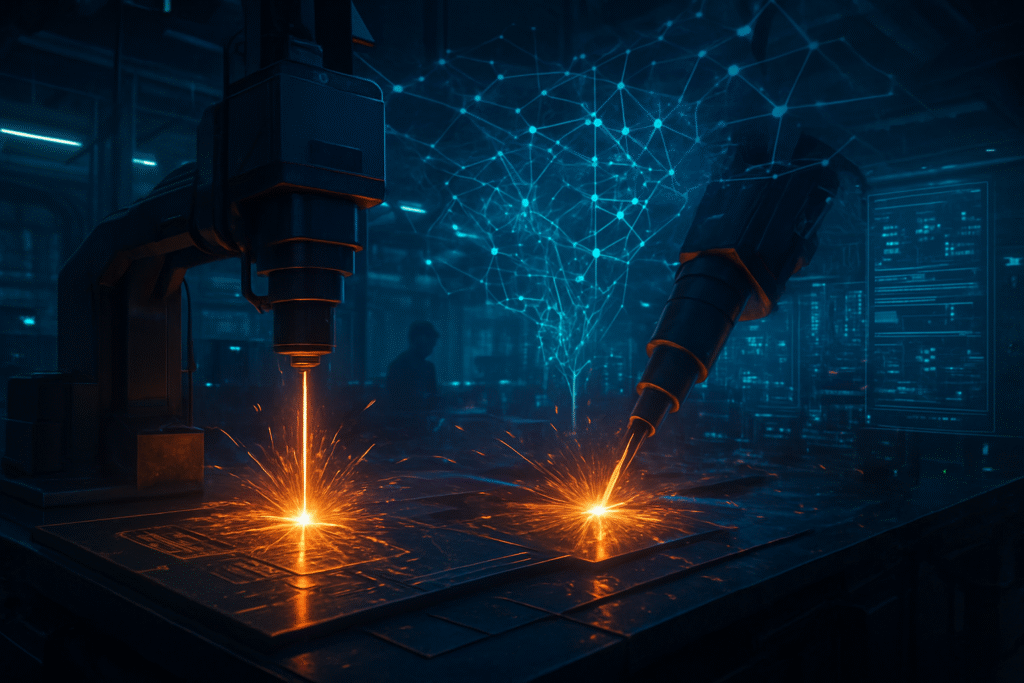
BOSTON, MA – November 13, 2025 – IPG Photonics (NASDAQ: IPGP), a global leader in high-performance fiber lasers and amplifiers, finds itself at a pivotal juncture, grappling with a volatile stock performance even as the broader fiber laser market experiences unprecedented growth. The company's recent trajectory underscores the complex interplay of technological innovation, intense competition, and shifting global economic currents that define the modern industrial laser landscape. While the market for fiber lasers is projected to surge to an estimated $12.8 billion by 2034, IPG Photonics' stock has navigated a period of mixed signals, with recent recoveries tempered by long-term declines, forcing investors and industry observers to scrutinize the underlying forces shaping this critical sector.
The immediate significance of these trends extends far beyond IPG Photonics, signaling a transformative era for the entire industrial laser industry. As manufacturing processes increasingly demand precision, efficiency, and automation, fiber lasers are becoming indispensable tools across diverse sectors, from electric vehicle production to advanced medical applications. IPG Photonics' ability to adapt and innovate within this rapidly expanding but highly competitive environment will not only dictate its own future but also offer a bellwether for the health and direction of a technology vital to global industrial advancement.
The Pulse of Innovation: Dissecting IPG Photonics' Technological Edge and Market Position
At the heart of IPG Photonics' enduring market presence is its relentless pursuit of innovation in fiber laser technology. The company’s vertically integrated manufacturing model allows it to control every aspect of production, from semiconductor diodes to complete laser systems, ensuring both quality and rapid iteration of new designs. This approach has yielded a portfolio of high-power continuous-wave (CW) fiber lasers, ranging from 1 kW to over 100 kW, renowned for their exceptional energy efficiency, often exceeding 40% wall-plug efficiency and even reaching over 50% for its YLS–ECO series. This efficiency not only translates into substantial operational cost savings for industrial users but also aligns with the global push for more sustainable manufacturing processes.
A significant differentiator for IPG Photonics lies in its advanced beam-shaping capabilities. The Adjustable Mode Beam (AMB) technology, for instance, represents a leap forward, offering a dual-beam configuration where a secondary ring beam encircles a primary core beam. The independent adjustability of these beams provides unprecedented control over laser-material interaction, proving particularly vital in applications like electric vehicle (EV) battery welding. Here, AMB lasers virtually eliminate common defects such as spatter and porosity, which are critical for the safety and reliability of EV power packs. This targeted innovation addresses specific, high-value manufacturing challenges, setting IPG Photonics apart from competitors who may offer more generalized solutions.
Beyond high-power CW lasers, IPG Photonics has expanded its technological prowess into ultrafast lasers (picosecond and femtosecond durations) for "cold processing" in micromachining, minimizing heat-affected zones in sensitive materials. Their Deep UV fiber lasers, operating at wavelengths shorter than 300 nm, further extend their reach into advanced microprocessing and scientific applications. The integration of real-time weld measurement (LDD technology) also provides in-process quality assurance, a feature highly valued in automated production lines. While competitors like Coherent (NYSE: COHR) and nLIGHT (NASDAQ: NLIT) offer strong laser portfolios, and Chinese manufacturers like Wuhan Raycus Fiber Laser Technologies provide cost-effective alternatives, IPG Photonics typically maintains an edge in beam quality, overall efficiency, reliability, and sophisticated beam delivery.
Initial reactions from the industrial automation and manufacturing communities have been largely positive, particularly regarding the tangible benefits of technologies like AMB in critical sectors such as automotive. Experts laud the increased speed, efficiency, and ability to process challenging materials that IPG's lasers enable. The AI research community, while not directly focused on laser hardware, increasingly recognizes the symbiotic relationship between AI and photonics. As AI drives demand for more advanced manufacturing capabilities, the precision and automation offered by high-performance lasers become indispensable. Conversely, photonics computing is emerging as a potential avenue for implementing AI algorithms with greater speed and energy efficiency. Despite these technological accolades, some analysts express caution regarding IPG Photonics' valuation, citing recent revenue fluctuations and intensified price competition, particularly from lower-cost providers in the Asian markets. This underscores the challenge of translating technological leadership into consistent financial outperformance in a rapidly evolving global market.
Corporate Chessboard: Navigating Competitive Currents and Market Shifts
The advancements championed by IPG Photonics and the broader fiber laser industry are not merely technical improvements; they are catalysts reshaping the competitive landscape for AI companies, tech giants, and a new generation of startups. As fiber lasers become more integrated with Artificial Intelligence in manufacturing and industrial automation, a symbiotic relationship is emerging, creating both immense opportunities and significant strategic challenges. Companies like IPG Photonics, with its new YLS-RI fiber laser platform and rack-integrated designs, are enabling more compact, efficient, and reliable laser systems, directly benefiting manufacturers seeking to optimize factory floor space and reduce operational costs.
The true beneficiaries of this technological convergence are multifaceted. Foremost are the fiber laser manufacturers themselves, including IPG Photonics, Coherent (NYSE: COHR), TRUMPF, Lumentum (NASDAQ: LITE), and nLIGHT (NASDAQ: NLIT), who are investing heavily in R&D to push the boundaries of power, precision, and efficiency. However, the ripple effect extends to AI companies specializing in industrial AI, machine vision, predictive analytics, and process optimization software. These firms see a surging demand for solutions that can harness the vast datasets generated by AI-enabled laser systems, enabling real-time adjustments for optimal cutting, welding, and marking parameters, thereby enhancing efficiency and ensuring consistent quality.
Tech giants with significant interests in hardware and manufacturing are also poised to capitalize. The automotive sector, particularly electric vehicle (EV) manufacturers, directly benefits from IPG's Adjustable Mode Beam (AMB) lasers, which offer unparalleled precision in battery welding—a critical process for EV safety and performance. Similarly, electronics and medical device companies can leverage fiber lasers for intricate micro-machining. Even cloud providers like Alphabet (NASDAQ: GOOGL), Amazon (NASDAQ: AMZN), and Microsoft (NASDAQ: MSFT) play a crucial role, providing the robust infrastructure necessary for real-time data analytics, digital twin integration, and remote monitoring of these advanced manufacturing processes. Alphabet's subsidiary, Taara, for example, is already exploring laser technology for high-speed data transmission, highlighting the broader impact of photonics.
This evolution brings significant competitive implications. Major AI labs and tech companies are increasingly compelled to deepen their hardware-software integration, either through strategic partnerships with laser manufacturers or through targeted acquisitions. The ability to offer comprehensive, AI-powered manufacturing solutions—from laser hardware to cloud-based analytics and AIaaS (AI-as-a-Service)—will become a key differentiator. Companies that can seamlessly integrate AI for superior precision, predictive maintenance, and adaptive processing will gain a strong competitive advantage, potentially disrupting traditional manufacturing techniques, displacing older CO2 lasers for metal processing, and transforming quality control and maintenance services from reactive to proactive, data-driven models. The shift towards more localized, on-demand manufacturing driven by AI-enhanced laser systems also signals potential disruption to established global supply chains, fostering new strategic alliances and talent competition in the intersection of AI and photonics.
Broadening Horizons: AI's Laser-Powered Future and Societal Impact
The profound integration of fiber laser technology with Artificial Intelligence signifies a pivotal moment in the broader AI landscape, moving beyond mere computational power to embed intelligence directly into the physical tools that shape our world. This synergy is a cornerstone of Industry 4.0, emphasizing smart manufacturing, automation, and interconnected systems. Fiber lasers, inherently digital and software-controlled, seamlessly integrate with robotics and advanced manufacturing platforms, with AI and machine learning algorithms processing vast amounts of data to enable intelligent decision-making and autonomous operation. Beyond industrial applications, fiber optic networks themselves serve as the indispensable physical backbone for the entire AI revolution, providing the high-capacity, low-latency data infrastructure demanded by complex AI models and generative AI. Intriguingly, research is even exploring the use of intense laser pulses through ultra-thin glass fibers to perform AI-like computations, hinting at a future where "thinking with light" could accelerate AI processing far beyond traditional electronics.
The impacts of this convergence are far-reaching, revolutionizing numerous industries. In manufacturing, AI-driven fiber lasers offer unprecedented precision and accuracy, dynamically adjusting parameters in real-time to compensate for material variations and environmental changes, leading to superior quality and reduced waste. The automotive and aerospace sectors benefit immensely from this capability, enabling the production of intricate components with sub-micron accuracy and ensuring the integrity of critical welds, such as those in EV battery manufacturing. The electronics and semiconductor industries rely on high-throughput micromachining for miniaturization, while medical device manufacturers leverage AI-enhanced precision for defect-free outcomes in producing implants and surgical tools. This intelligent automation not only boosts productivity and reduces costs but also fosters greater customization and flexibility across diverse applications, from jewelry design to renewable energy component fabrication.
However, this transformative shift is not without its concerns. A primary worry is job displacement, as AI-driven automation significantly increases productivity while potentially reducing the need for human labor in many manufacturing tasks. This necessitates a proactive approach to workforce retraining and adaptation. Furthermore, the ethical implications of AI in automation are growing in prominence. Questions of liability for autonomous systems, worker privacy in AI-monitored environments, and the critical need for "explainable AI" to build trust and accountability are becoming paramount. As AI systems become more adaptive, the legal and ethical frameworks must evolve to address who is responsible when an AI-driven machine makes a flawed decision. While AI promises to enhance supply chain resilience through predictive analytics, the increasing complexity and reliance on advanced technology within these supply chains could also introduce new vulnerabilities if not managed with robust cybersecurity and diversified sourcing strategies.
Compared to previous AI milestones, this integration represents an evolution beyond simply automating pre-programmed tasks or even duplicating human intelligence. It is about enabling machines to perform tasks in ways humans cannot, driving a true digital transformation across all organizational processes. This era moves beyond the traditional "Moore's Law" of transistor-count scaling, focusing instead on building intelligence directly into physical systems with precision and real-world feedback, leveraging photonics to overcome the physical and economic limits of data transfer and processing. It is analogous to the impact of the transistor revolution or the widespread adoption of GPUs, but specifically targets embedding intelligence into the very fabric of industrial production, making manufacturing smarter, faster, and more precise than ever before.
The Road Ahead: Charting the Future of Laser-AI Synergy
The convergence of fiber laser technology and Artificial Intelligence is not merely a fleeting trend but a fundamental shift that promises to redefine industrial capabilities and beyond. In the near term, within the next one to three years, we can expect to see fiber laser systems become even more intelligent and efficient. AI will drive real-time optimization of laser parameters—power, speed, and focus—to an unprecedented degree, leading to greater precision, reduced errors, and higher-quality outputs in processes like cutting, welding, and engraving. Predictive maintenance, powered by AI algorithms analyzing sensor data, will become a standard feature, significantly reducing downtime and extending equipment lifespan. Furthermore, the relentless pursuit of higher power and efficiency will continue, enabling fiber lasers to cut through increasingly thick and robust materials, such as 30mm+ stainless steel, while adaptive optics will dynamically shape beams for optimal results, regardless of material or environmental variations. Miniaturization and increased portability will also broaden the accessibility and application range of these powerful tools.
Looking further out, beyond three years, the landscape is set for even more transformative changes. Experts foresee the advent of fully autonomous production cells where fiber laser systems, integrated with robotics and advanced data analytics, will operate with minimal human intervention, tackling complex tasks like 3D cutting and engraving. Hybrid automation, combining multiple processes into single, intelligent workflows, will streamline manufacturing from start to finish. AI-powered simulation and digital twins will become standard, enabling comprehensive optimization and continuous improvement across entire manufacturing ecosystems. The ability of AI to adapt to new and composite materials in real-time will also unlock new possibilities in advanced material science. Furthermore, the long-term vision includes the potential integration of fiber lasers and AI with quantum technology and augmented reality, opening up entirely new paradigms for manufacturing, medical technology, and scientific exploration.
The potential applications and use cases on the horizon are vast and varied. In advanced manufacturing, AI-driven fiber lasers will enable mass customization and smart micro-fabrication, catering to highly specialized product demands. The medical sector stands to benefit immensely, with AI enhancing precision for surgical procedures, dermatological treatments, laser therapy for conditions like cancer, and the creation of intricate medical implants. Telecommunications will continue to rely on fiber lasers for next-generation fiber optic communication systems, supporting the exponential demand for faster internet and higher bandwidth. Aerospace, defense, and even consumer electronics will see more precise and efficient manufacturing of critical components, while industries like jewelry and art will leverage AI for intricate, customized designs.
Despite this immense promise, significant challenges must be addressed for widespread adoption and responsible development. The high initial cost of advanced AI-enabled fiber laser machines and the complexity of integrating new AI and digital technologies with existing manufacturing systems can be prohibitive for smaller enterprises. A critical skill shortage in AI, machine learning, and advanced robotics within the traditional manufacturing workforce also needs urgent attention through investment in training and education. Moreover, the increased connectivity of AI-driven systems introduces substantial cybersecurity risks, necessitating robust protection for sensitive data. Perhaps most importantly, the ethical development of AI remains a paramount concern, encompassing issues such as algorithmic bias, data privacy, the potential for over-reliance and loss of human control, job displacement, and the responsible use of AI for societal benefit.
Experts universally predict continued transformative growth for the fiber laser industry, with AI and IoT integration becoming standard features in fiber laser systems. This will lead to smarter, more adaptive, and highly connected manufacturing environments, potentially boosting productivity by up to 40%. The dominance of AI-enhanced fiber laser cutting machines in metal fabrication is expected to solidify, driven by unmatched accuracy, automation, and speed. The prevailing sentiment is that AI will act as a powerful enabler, supporting human judgment, providing insights, and optimizing processes, rather than simply replacing human workers. Companies that strategically invest in AI integration, workforce upskilling, and system connectivity are poised to lead this next chapter of manufacturing, while a strong focus on sustainability, leveraging fiber lasers' energy efficiency and AI's optimization capabilities, will guide future developments.
A Laser-Focused Future: IPG Photonics at the Forefront of AI-Driven Manufacturing
The journey of IPG Photonics (NASDAQ: IPGP) and the broader fiber laser market into the mid-2020s paints a vivid picture of technological dynamism, economic volatility, and profound societal implications. As a pivotal player, IPG Photonics navigates a landscape where its stock performance, though showing signs of recovery, reflects the intense competitive pressures and economic sensitivities inherent in a rapidly evolving global market. The company's unwavering commitment to innovation, particularly in high-power, high-efficiency fiber lasers and advanced beam-shaping technologies like AMB, positions it as a critical enabler for the future of precision manufacturing, especially in high-growth sectors such as electric vehicles and micro-machining.
The overarching significance of this period lies in the accelerating convergence of fiber laser technology with Artificial Intelligence, ushering in an era of intelligent automation that is fundamentally reshaping industries. This synergy is not merely an incremental improvement; it represents a paradigm shift towards Industry 4.0, where self-optimizing, highly precise, and interconnected manufacturing systems are becoming the norm. From real-time quality control and predictive maintenance to fully autonomous production cells and the exploration of "thinking with light" for AI computations, the integration of AI is amplifying the inherent strengths of fiber lasers to unlock capabilities previously confined to science fiction.
However, this transformative journey is accompanied by significant challenges that demand careful consideration. The economic hurdles of high initial investment and the technical complexities of integrating advanced AI systems are substantial. More critically, the ethical dimensions of AI in automation, including potential job displacement, data privacy concerns, the need for explainable AI, and ensuring corporate responsibility, require proactive dialogue and robust frameworks. The future success of companies like IPG Photonics, and indeed the entire industrial laser sector, will hinge not only on their ability to innovate technologically but also on their capacity to address these societal and ethical considerations responsibly.
In the coming weeks and months, all eyes will be on IPG Photonics' financial performance, particularly its ability to sustain recovery in its core materials processing segment amidst fierce competition from lower-cost providers. Investors will scrutinize the impact of its strategic diversification into medical and micro-machining markets, and its continued advancements in AI-integrated solutions. Beyond individual company metrics, watch for broader industry trends: the continued acceleration of AI adoption in manufacturing, the development of new fiber laser applications, and how regulatory bodies and industry leaders grapple with the ethical implications of increasingly intelligent automation. The laser-focused future is here, and its trajectory will be defined by how intelligently and responsibly we harness its immense power.
This content is intended for informational purposes only and represents analysis of current AI developments.
TokenRing AI delivers enterprise-grade solutions for multi-agent AI workflow orchestration, AI-powered development tools, and seamless remote collaboration platforms.
For more information, visit https://www.tokenring.ai/.





